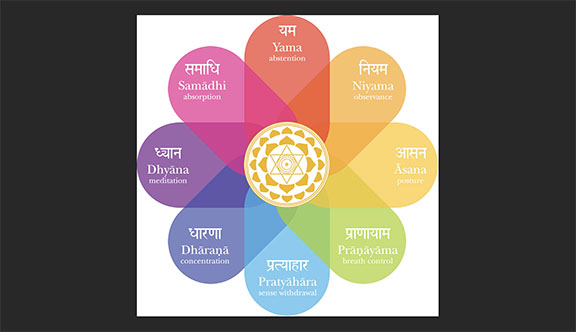 The first two limbs of Raja Yoga are called yama and niyama. They consist of five precepts each and constitute the ethical foundation of Yoga. Sri Swami Satchidananda said: “All spiritual life should be based on these principles. They are the foundation stones without which we can never build anything lasting.”
The first two limbs of Raja Yoga are called yama and niyama. They consist of five precepts each and constitute the ethical foundation of Yoga. Sri Swami Satchidananda said: “All spiritual life should be based on these principles. They are the foundation stones without which we can never build anything lasting.”
Ultimately, the goal in spiritual practice is to make the mind calm and clean. Such a mind is like a crystal clear lake; we can see to its depths and experience our true nature, which is supreme peace and joy. Without adherence to yama and niyama, it would be impossible to keep the mind calm and clean always.
By working with these precepts, we come to a deeper understanding of our attitudes and behaviors — the ways we treat ourselves, others, and the world around us. This insight leads to personal transformation and spiritual awakening. This benefits not only ourselves, but helps to bring peace and comfort, healing and light, to others.
Below are some practical hints on how to explore these precepts so they become integrated into your daily life and spiritual practice.
- Goal Setting: Honestly evaluate your capacity. Then, be specific and practical in setting a goal. Make your goal challenging, but attainable; if you apply proper effort, you will succeed. If you make it too hard, you will only set yourself up for frustration and failure, and give your mind an excuse to give up. This is a trick of the mind that can undermine your progress. Don’t try to reach too far, too fast. Slow and steady wins the race. Even if you are focusing on what may seem like a small, mundane thing, what you’re really doing is cultivating greater awareness that can then express in other areas of your life.
- Consequences: Designate a consequence in case you slip. Let it be another beneficial practice: like more pranayama, meditation, service, or a dietary observance. That way, you will be continually asserting your mastery over the mind. Be creative; make it fun. Lovingly, patiently, skillfully win over any inner resistance, so that your mind becomes your ally on your spiritual journey.
- Positive affirmations: State what you wish to develop clearly, succinctly and in the present tense—as if you already possess it. If you practice mantra japa, repeat your affirmation several times before the silent repetition of your mantra. When you do that, the power of the mantra goes to fulfill the intention behind your affirmation. It’s also very helpful to repeat the affirmation several times upon arising and before retiring at night. That way, you will be continually integrating the virtue you are developing into your character and expressing it more and more in your life.
- Pratipaksha Bhavana: This yogic technique helps to overcome negative patterns by consciously cultivating the opposite positive ones. It can be combined with alternate nostril breathing. As you inhale, visualize that along with the breath, you are drawing into yourself the positive quality you wish to develop. Feel like it is filling you completely. When you exhale, visualize that the negative pattern is leaving with the breath. While it’s difficult to change emotional and behavioral habits directly, this single technique can help a lot. Because it is so simple, it can bypass the mind’s resistance to change. Try practicing for ten minutes, twice a day, for a month, and you will see the benefits.
- Inspiration: Find out more about others who have developed and expressed in their lives the virtue you’re practicing. You can draw examples from the saints and sages of the various faith traditions or from leaders in different fields, such as: education, government, science, technology, business, sports, or the arts. If you look around you, you can draw inspiration from family members, colleagues, teachers, students, and friends. Seeing the virtue expressed in the lives of others can make your goal feel more accessible and serve as a powerful motivator for your practice.
- Personal accountability: Every day, pause, reflect, and record your progress in a spiritual journal. A few moments a day in this way will help you to stay on track and deepen your spiritual discernment. A greater understanding of the meaning, benefits, and power of the virtue you are developing will be revealed to you.
- Support: This is very important on the spiritual path. We can draw support from the Higher Power through prayer and our sincere, heartfelt efforts. We can also draw support from one another—from a spiritual buddy, a mentor, a teacher, or a friend. This can help to reinforce our commitment, as well as be a source of valuable feedback, as our journey unfolds.
YAMA (Abstinence)
1. Ahimsa Non-violence
2. Satya Truthfulness
3. Asteya Non-stealing
4. Brahmacharya Continence (or moderation)
5. Aparigraha Non-greed
NIYAMA (Observance)
- Saucha Purity
- Santosha Contentment
- Tapas Accepting pain and not causing pain
- Svadhyaya Spiritual study
- Isvarapranidhana Devotion, dedication and surrender to the divine
About the Author:
 Swami Karunananda is a senior disciple of Sri Swami Satchidananda. In 1975, she was ordained as a monk into the Holy Order of Sannyas. She has had almost 50 years experience teaching all aspects of Yoga and specializes now in workshops, retreats, and teacher training programs that focus on the science of meditation, the philosophy of Yoga, personal transformation, and Yoga breathing techniques for better health and well-being. She developed, and for 30 years has taught, the Integral Yoga Teacher Training programs in Raja Yoga and in Meditation.
Swami Karunananda is a senior disciple of Sri Swami Satchidananda. In 1975, she was ordained as a monk into the Holy Order of Sannyas. She has had almost 50 years experience teaching all aspects of Yoga and specializes now in workshops, retreats, and teacher training programs that focus on the science of meditation, the philosophy of Yoga, personal transformation, and Yoga breathing techniques for better health and well-being. She developed, and for 30 years has taught, the Integral Yoga Teacher Training programs in Raja Yoga and in Meditation.
Swami Karunananda served as president of Satchidananda Ashram–Yogaville in Virginia and in California, as well as director of the Integral Yoga Institutes in San Francisco and in Santa Barbara. She currently serves on the Board of Trustees, and as the chairperson of the Spiritual Life Board at Satchidananda Ashram–Yogaville, Virginia.
Interested in fostering interfaith understanding and harmony, she is featured in the interfaith documentary entitled, With One Voice. She also compiled and edited the Lotus Prayer Book, a collection of prayers from various faith traditions, and Enlightening Tales as told by Sri Swami Satchidananda. She served as contributing editor for The Breath of Life: Integral Yoga Pranayama, as well as a senior writer for the Integral Yoga Magazine. In her book, Awakening: Aspiration to Realization Through Integral Yoga, she describes the spiritual path and provides guidance for the journey.


